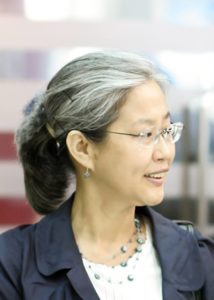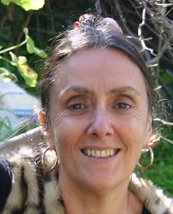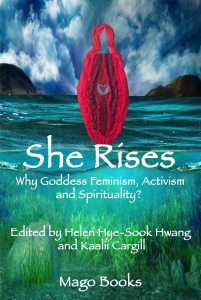She Rises: Why Goddess Feminism, Activism, and Spirituality? Volume 1 (Sister Book of She Rises: How Goddess Feminism, Activism, and Spirituality? Volume 2)
Or buy them at Mago Bookstore!
Sample pages flipbook (Table of Contents, Introduction, Authors). Free download available at the bottom of the menu bar in the flip book. You can also add a specific page number after clicking the page number indicator.
Editors Helen Hye-Sook Hwang and Kaalii Cargill
Project Committee Trista Hendren and Wennifer Lin
Publication Date June Solstice, 2015
- Paperback:476 pages
- Publisher: Mago Books (June 21, 2015)
- Language:English
- ISBN-10:1514257696
- ISBN-13:978-1514257692
- Product Dimensions: 6 x 1.1 x 9 inches
- Shipping Weight:8 pounds
- Anthology: 92 Contributors
See Press Kit and She Rises Vol 1 Book Reviews.
Description This book may be seen as a guidebook to the consciousness of the Great Goddess, the primordial consciousness of WE in S/HE, by contemporary Goddessians. The question, “Why Goddess Feminism, Activism, and Spirituality?” taken as the warp, is interwoven with the weft of the answers provided by 92 contributors from around the world. She Rises puts forth ever-unfolding patterns of Goddessian thoughts, experiences, and visions expressed through a variety of works including short writings, poems, essays, artworks, and research papers. Our authors take us far and near, from the cosmic horizon to the very political site of one’s inner feeling. Probing the very foundation of one’s thinking/feeling/sensing, She Rises collectively re-members and re-stores what has been forgotten or rather erased in the mind of people under the advancement of patriarchal times. The acoustic/semantic/visual chorus of this book sometimes whispers and other times trumpets the premise that knowing the Goddess is a beginning of one’s action to re-create the self and the world. More to the structure, She Rises taps into the gynocentric power of the numeric symbolism of three and nine by (1) calling Parts as Mothers and Chapters as Sisters and (2) inventing the Nine Sisters under the Three Mothers.
Excerpt from the Introduction
The project began with a question: Why Goddess Feminism, Activism, and Spirituality?
The answers poured in from around the World and are collated here into three parts (Mothers) of three chapters (Sisters) each.
- Mother One: “Why Goddess Feminism?”
Artist Lucy Pierce begins by saying that “Our capacity as women to hold space for each other, to hold and nurture, encourage and stretch, nourish and behold one another is an almighty magic which is changing the vibration of the planet.”
Sister East: Iyanifa Ayele Kumari describes her experience of realizing that “the first divinity known on the planet looked like me, a black woman”; Helen Hye-Sook Hwang says “It has to be Mago, the Female Divine, because She is real!” Glenys Livingstone describes “the Way the Cosmos was for a Country girl 1954 C.E.” Carol P. Christ explores “Why Women Need the Goddess”.
Sister South: Hearth Moon Rising tells us that “Worshiping the Goddess is only natural for a species born of women.” Kaalii Cargill: “Valuing and honouring the life-giving power of the Feminine is the pathway of survival . . .” Andrew Gurevich: “I am a Goddess Feminist because I understand that we have close to 600,000 years of mythological and sociocultural expression of the sacred feminine archetype.” Andrea Nicki’s poetry describes “ . . . too many offerings of wine-blood and bread-body.” Judith Shaw expresses Goddess power through her images and words: “Women and men together, from the Middle East to the Midwest, are spreading their wings and demanding a return to balance.” Angharad Wynne reminds us that “Giving free rein to creative expression and play is vital.” Vicki Noble honors Mary Daly: “There are and will be those who think I have gone overboard. Let them rest assured that this assessment is correct, probably beyond their wildest imagination, and that I will continue to do so.” Judy Foster describes ritual female figurines: “She is One and she is Many . . .” In art and words, Yia Alias shows that “Reverence for All Life becomes our common Spirituality.” Danica Anderson explores how “feminism no longer protects women.”
Sister West: Mary Ann Beavis asks “Doesn’t God/dess include God?” Esther Essinger tells us that “Goddess is NOT ‘G*D’ in a skirt.” Debbie Willis writes of how she “wanted a deity with whom I, as a female, could identify.” Leslie Carol Botha explores the sacred triphasic aspect of “Maiden, Mother and Wise Woman”. Robin Scofield begins her poem: “From Goddess to prostitute is not at all a fall.” Shaktima Brien, in word and image, finds her way home to the Goddess. Susan Hawthorne’s poem bring us “what the mythmakers say”. Laura Newberry-Yokley elaborates Pandora archetypes, exhorting us to “examine the belief systems we buy into.” Max Dashu clears up some of the confusion about Goddess veneration, reminding us that “Invoking the names and images of Goddess answers a deep hunger in women, and among a growing number of men, to restore balance, for justice and truth.”
- Mother Two: Why Goddess Activism?
Artist Lydia Ruyle brings us her banner of Hecate – the guardian of the crossroads who holds swords of discernment and fires of transformation.
Sister North: Harriet Ann Ellenberger’s tribute to Barbara Mor; Lise Weil writes of Barbara Mor’s “uncompromising fury on behalf of women and the earth”; Barbara Mor remembers the Picts; Trista Hendren describes how “feminism without the Goddess does not reach far enough to change the root of our oppression”; David Hazard says that “we need the great woman to arise and split the angry atmosphere of the world with equally fierce compassion.” Harriet Ann Ellenberger shares her learning that “the imagery and concepts of patriarchal religion justify and are embedded in the material structures of oppression.” Janine Canan poetically speaks against the desecration of the sacred body; Janie Rezner tells us that “This is the war we have been waiting for! And our Mother is here to guide us!” Eileen Haley’s quilting celebrates women’s energy throughout human history and around the World. Susan Hawthorne reminds us of Monique Wittig’s words from her novel The Guérillères:
There was a time when you were not a slave, remember that. You walked alone, full of laughter, you bathed bare-bellied. You say you have lost all recollection of it, remember … You say there are no words to describe this time, you say it does not exist. But remember. Make an effort to remember. Or failing that, invent.
Genevieve Vaughan describes how “Protesting against patriarchy is a spiritual necessity.”
Sister Center: Liona Rowan says: “We all die if the planet dies.” Cedar Cat predicts that “The wise crones will rise to lead the world.” Harita Meenee offers a “strong reminder that the bodies, hearts, and minds of women (and people of all genders) refuse to submit to patriarchal stereotypes and destructive social norms.” Ingrid Andrew celebrates as “The charcoal woman rises from the land.” Elaine Drew shares her image of “Pomona- Fruits of the Garden”, and Stacey Hughes argues that “woman IS the origin of human life just as much as all the universe itself has been created within a receptive/feminine void”; Kat Hathaway shares a personal story in which “resistance is fertile”; Janie Rezner asks “What will it take?”; Yvonne M. Lucia brings us Mary Daly: “When the God is male, the male is God.” Andrew Gurevich explores the “serious illness in the national (American) psyche; signs of our lost loyalty”, and Harriet Ann Ellenberger: “Break the chain, they say, and you do.”
Sister Wind: Catherine Wright, quoting Ntozake Shange: “I found god in myself, and I loved her, I loved her fiercely.” Lila Moore explores “through dance-ritual and art films the interaction of the body and psyche with the natural environment and technology.” Phibby Venable reminds us that “There is a goddess hidden in so many of the females I see that cry, and then try again.” Jayne Marie deMente writes that it is “important to create again, a female language”; Claudia Morgana Vico is a “Goddessian because I/we need to overcome patriarchy.” Dave Warren: “it is the long suppressed and repressed Divine Feminine that might be our only salvation at this point.” Chickie Farella’s message is: “Find Your Mother, The Mother In You . . .And The Rest Will Follow.” Serdar Ferit works in Ethiopia to promote gender equality in education; Esther Ellen Wildblood: “We are Her voices and we will not be silenced.” Donna Snyder describes how compassion Goddess hears the cries of the World; Mary Saracino hears “The wandering Maenads cry: ‘This is no country for old women.’” Lydia Ruyle offers guidelines for birthing a Motherworld; Starhawk reminds us that “Spirituality is also about challenge and disturbance, about pushing our edges and giving us the support we need to take great risks.”
- Mother Three: Why Goddess Spirituality?
Artist Jassy Watson gives us Pachamama – “From Her we arrive . . .and to Her, we shall return.”
Sister Fire: Alisa Velaj: “I again pray after silence and stay silent after prayer.” Jeri Studebaker describes how “Utopia vanished when Mother Goddesses did.” Sara Wright tells us that “Women need images of the Divine Feminine to access the archetypal field of the goddess”; Songstress Kellianna: “Oh, Mother we are grateful for all you do, And we have come together now in praise of you.” Pegi Eyers explores the core beliefs and values of Goddess spirituality and offers a cautionary tale. Leslene della-Madre asks us “Why are we so afraid to die?” Rosemary Mattingley writes about the Mago pilgrimage to Korea; Barbara Daughter asks: “Can our world be imagined without the generative and nurturing powers of females?” Suzanne Bailie asks “What Does The Moon Goddess Do?” Ingrid Andrew’s poem: Ing’s Ride; Janine Canan: “The Earth is my Mother.” Diane Horton explores the varied and interesting ways of embracing the Goddess. Artist Sandra Curtis depicts the vulva as an archetypal symbol, and Judy Williams describes her experience of developing “vagina eyes”. Marie de Kock: “If the man-made world is allowed to continue to mine, rape, destroy and interfere with everything natural, well… everything Natural will become extinct.”
Sister Water: Yvonne M. Lucia gives a “talisman of hope” in the Lady of Guadalupe; Leslene della-Madre describes Goddess as “the plasMA of the YoniVerse”; Amy Barron Smolinski has four sons and is raising men of the Goddess; Michela Zucca shares her four years of research into the “archaic sub stratum of mysterious origin . . . in which woman was the supreme administrator of power” in the Alps and Pyrenees; Donna Snyder on finding the Goddess: “From then on, everywhere I lived, I found Her there before me.” Jenna Farr Ludwig calls for us to remember that “we are being charged with the duty to embrace the nature-soul-matter-body-loving energy of the Divine Feminine before it is too late, not only for ourselves, but for future generations.” Lizette Galima Tapia-Raquel poetically describes how she discovered the Goddess within; Jillian Parker takes us on a journey “Along the Path to the holy Mother”. Annie Finch honors Inanna; Andrea Nicki: “Women, what if we had a Goddess who was mentioned everyday?” Kaalii Cargill’s ode to the Goddess; Amitabh Vikram Dwivedi: “O Goddess! You are the sweetest; you are the supreme.” Xanath Caraza celebrates Ancestral Strength; Sandra Torez’s poem: “from the sea floor I rise . . .” Glenys Livingstone shares a paper presented at the Women of Faith Colloquium, International House, University of Sydney, 22nd September 1997.
Sister Earth: Marie de Kock: “Female spirituality is the door.” Annie Finch: “Goddess is completely different from God.” Marija Krstic-Chin writes that Goddess spirituality allows us to “remember who we really are”; Michael Brautigan reminds us that “wisdom is a Goddess”; Sam Ledger turns to the Goddess as “reminder of my Divinity and Power!” Paola Suarez tells her Goddess story; Bridget Robertson describes her experience as a Goddessian; Vicki Schroeder: “These women knew that without the spiritual power of the Goddess, change would not happen in their world.” Janet Hulston: “May we EMBODY Love”. Jane Hardwicke Collings feels the Goddess work though her and it feels divine; Helen Hye-Sook Hwang shares her “dream to bring my ancient tradition alive and to carry on the Magoist mission my foremothers passed on to me.” Blair Mirth makes a dedication to Dark Descent; Luciana Percovich explores Embodied Divinity; Mary Saracino: “As a species, we have forgotten where we come from. We have lost our way. We need to come home. We need to stop the hate, the bigotry, the fear, the perpetual violence that keeps us imprisoned in the wrong kind of cycle. That’s why Goddess matters.”
- With art work by Lucy Pierce, Yia Alias, Kaalii Cargill, Rena Hoffman, Judith Shaw, Emilie Mitcham, Shaktima Brien, Max Dashu, Mary Coughlan, Eileen Haley, Elaine Drew, Julie Stewart Rose, Lydia Ruyle, Jassy Watson, Pegi Eyers, Ingrid Andrew, Sandra Curtis, Yvonne M. Lucia, and Janie Rezner.
Meet Editors
 Helen Hye-Sook Hwang
Helen Hye-Sook Hwang
Helen Hye-Sook Hwang, Ph.D. is scholar, activist, and advocate of Magoism, anciently originated tradition that venerates Mago as the Great Goddess. She earned her MA and Ph.D. in Religion with emphasis on Feminist Studies from Claremont Graduate University, CA. She also studied toward an MA degree in East Asian Studies at UCLA, CA. Hwang has taught for universities in California and Missouri, U.S.A. Since 2012, Dr. Hwang has founded and directed The Mago Work whose branches include the Return to Mago E-Magazine (http://magoism.net), Mago Academy (http://magoacademy.org), and Mago Books (https://www.magobooks.com). Together with Mago Sisters, she also founded Gynapedia(http://www.gynapedia.com) and Mago Pool Circle (http://www.magopoolcircle.net) to broaden The Mago Work. She co-edited and published She Rises: Why Goddess Feminism, Activism, and Spirituality? Volume 1 (Mago Books, 2015) and She Rises: How Goddess Feminism, Activism and Spirituality? Volume 2 (Mago Books, 2016). Also authored The Mago Way: Re-discovering Mago, the Great Goddess from East Asia(Mago Books, 2015). For more, see here.
 Kaalii Cargill
Kaalii Cargill
Kaalii Cargill, author of DON’T TAKE IT LYING DOWN: LIFE ACCORDING TO THE GODDESS, lives and works in Melbourne, Australia. She has been involved in women’s consciousness raising groups, home birth, attachment parenting, home and parent-run schooling, and she co-developed Soul Centred Psychotherapy, a therapeutic modality based on the feminine principle. Kaalii has worked extensively in sacred ritual space and currently runs ongoing dream groups. Kaalii inherits a sense of mystery from Calabrese, ‘strega’ grandmothers and a healthy resistance to enculturation from her Romany ancestors. Kaalii’s latest novel, DAUGHTERS OF TIME, is interwoven with archaeological, historical, and mythological details that reveal the ancient world. It follows a line of daughters through ancient Sumer, Egypt, and Jerusalem, and into the modern world, as they carry the memory of the Goddess through time and across continents to the present day where three women come together to save the world from environmental catastrophe. For more, see here.
Read about She Rises Volume 1
(Book Excerpt 3) Introduction From She Rises by Helen Hye-Sook Hwang)
(She Rises 3) Introduction by Kaalii Cargill
(She Rises 2) Introduction by Trista Hendren
(Book Excerpt 2) Introduction from She Rises: Why Goddess Feminism, Activism, and Spirituality?
She Rises Memes: Contributors Speak!
Highlights by Our Contributors

